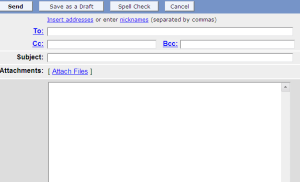Living in a “MAIL” dominated industry
In today’s corporate contour, only email speaks not Men and Women, and any of your email is powerful enough to trap you at any point during your tenure. Hence, writing emails / giving replies to the emails have emerged as a “Rocket Science”. Some mid-volume companies uses email multiplication model where a copy of an email received by an employee is automatically sent to his/her boss & moving ahead any email received by the boss will auto “cc” to the superior boss. So, consider following points while writing a professional email.

The DO’s of Email at Work…
DO: Personalize
Personalization is the first point to remember while writing an email irrespective to whom it is intended. Address the recipient by his / her first name prefixing Mr./Mrs.
Tip: Make a habit to add “Dear” Mr. / Mrs [NAME], in all emails
DO: Adapt
Recognize the recipient through your past communication / old emails. Find out their tone & use words accordingly. In India, sometimes recipients feel offended when they receive straight forward email seeking some response / answer
Tip: You may look at the signature of the emails to find about the recipient
DO: Always Check Before Clicking Send
It is the mandatory point to remember before sending the email. Double check your email (spellings, attachments)
Tip: Do not include the recipient email address in the send line “To” until you’ve proofed.
DO: Keep Messages Short
Official emails are generally read during office hours, hence it is recommended to keep them short to save time of the reader/s, don’t repeat sentences
Tip: Use short sentences rather than long paragraphs
DO: Keep Your Inbox Clean
By keeping the “Inbox Clean” the intention is to read all the messages. But sometimes due to priorities emails could be skipped.
Tip: The best way to handle this is to create recipient specific Inbox folders & read emails as per priority.
The DON’Ts of Email at Work…
DON’T: Abbreviate
Sometimes our habit follows up everywhere. Use.of shortcut terms like “thx”, “lol” or “c u @ wrk l8r”. are very often in our daily life. Never use the stuff on professional emails, this reflect the casual behavior towards recipient
Tip: Use Skype for informal response
DON’T: !!!!!!!!! 🙂 🙁 CAPS LOCK ON
Over use of signs like exclamation points can raise unnecessary reader attention. Hence must be used in a right context, wherever actually required. Similarly use of smileys / emicons looks great on informal chat rather than professional emails.
Use of words in CAPITAL LETTERS represents anger & shouting thus should be avoided on professional emails.
Tip: Don’t immediately respond to messages that make you angry, think & then write.
DON’T: Send the One Word “Okay” or “Thanks” Response
Not to counter the point above, but keeping messages short is ideal, sending the dreaded, non-descriptive one word email is not so ideal. Sending content for edits or emails that require a detailed answer can’t be answered with a simple “okay”, give the sender the courtesy of the answer or closure they need, as to not drag on the email chain with answers that don’t clarify what is being asked.
DON’T: Drag Irrelevant Readers
Don’t overuse carbon copies. Make sure if the recipients really need to see the information
Tip : Include people those who are part of the discussion. For information to others you may add them as “Bcc”.
DON’T : Excessively use Pronouns & Absolutes
Pronouns establish the tone. The most dangerous pronoun in an e-mail is “you.”. Avoid words such as: never, always, impossible, or cannot. Soften the absolutes if you want to be more credible in e-mails.
Tip: Keep the communication open & generic, never write negative on email

